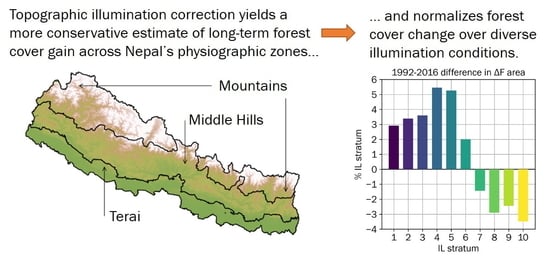Shedding New Light on Mountainous Forest Growth: A Cross-Scale Evaluation of the Effects of Topographic Illumination Correction on 25 Years of Forest Cover Change across Nepal
Abstract
1. Introduction
- Quantify differences in forest cover classification accuracy using TIC and non-topographic illumination corrected (nonTIC) data;
- Quantify differences in the extent and geographic distribution of forest cover change with TIC and nonTIC approaches; and
- Quantify differences in type of forest cover change (e.g., regenerated or lost forest cover) using TIC and nonTIC approaches.
2. Materials and Methods
2.1. Study Area
2.2. Data and Materials
2.3. Landsat Image Topographic Correction, Annual Compositing, and Trend Construction
- Distance to the peak greenness date (1 September): Since pixels acquired closer to the peak greenness date are more helpful for discriminating forest cover, we assigned a weight of 1 to pixels acquired on September 1 and a value of 0.1 to pixels acquired at the beginning (1 July) or end (31 October) of the growing season following a Gaussian curve.
- Proximity of the pixel to clouds or cloud shadows: While CFmask is broadly effective at removing clouds and cloud shadows, some cloud or shadow pixels may remain, which would degrade the classification. We therefore weighted pixels by their Euclidean distance to clouds or cloud shadows using a Sigmoid function. Pixels more than 1500 m away from clouds or cloud shadows were given a weight of 1; for pixels closer than 1500 m, weights linearly decreased to 0 for pixels adjacent to clouds or cloud shadows.
- Quality of NIR reflectance: In a further effort to exclude shaded (low NIR value) or clouded pixels (high NIR value) in our classification, we calculated the median of all growing season images within a given year and assigned pixels with an NIR value equivalent to the median a weight of 1; pixels with the largest absolute deviation from the median were given a weight of 0. Using the median and the largest absolute deviation from the median, we linearly distributed weights between 0 and 1 to all other pixels based on their absolute deviation from the median.
2.4. Forest Cover Classifier Model Construction
Objective 1: Compare nonTIC and TIC Classification Accuracy
Objective 2: Measure the Effect of TIC on Long-Term Forest Cover Change
Objective 3: Measure the Effect of TIC on Type of Forest Cover Change
3. Results
Objective 1: Compare nonTIC and TIC Classification Accuracy
Objective 2: Measure the Effect of TIC on Long-term Forest Cover Change
Objective 3: Measure the Effect of TIC on Type of Forest Cover Change
4. Discussion
5. Conclusions
Author Contributions
Funding
Institutional Review Board Statement
Informed Consent Statement
Data Availability Statement
Acknowledgments
Conflicts of Interest
Appendix A
| Year/Month | July (7) | August (8) | September (9) | October (10) |
|---|---|---|---|---|
| 1992 | 4 | 8 | 11 | 12 |
| 1993 | 10 | 13 | 7 | 14 |
| 1994 | 13 | 9 | 17 | 23 |
| 1995 | 3 | 7 | 2 | 6 |
| 1996 | 9 | 7 | 20 | 20 |
| 1997 | 6 | 11 | 12 | 16 |
| 1998 | 4 | 7 | 17 | 19 |
| 1999 | 7 | 7 | 14 | 21 |
| 2000 | 9 | 11 | 23 | 24 |
| 2001 | 16 | 20 | 18 | 12 |
| 2002 | 7 | 9 | 11 | 18 |
| 2003 | 6 | 7 | 3 | 14 |
| 2004 | 14 | 13 | 26 | 36 |
| 2005 | 7 | 13 | 25 | 30 |
| 2006 | 8 | 11 | 35 | 32 |
| 2007 | 7 | 12 | 19 | 23 |
| 2008 | 11 | 10 | 27 | 47 |
| 2009 | 21 | 15 | 35 | 44 |
| 2010 | 8 | 10 | 17 | 41 |
| 2011 | 14 | 20 | 23 | 37 |
| 2012 | 2 | 10 | 19 | 29 |
| 2013 | 20 | 26 | 48 | 46 |
| 2014 | 20 | 30 | 38 | 53 |
| 2015 | 32 | 25 | 50 | 50 |
| 2016 | 13 | 39 | 37 | 51 |
| Total | 271 | 350 | 554 | 718 |
References
- Beniston, M. Climatic Change in Mountain Regions: A Review of Possible Impacts. In Climate Variability and Change in High Elevation Regions: Past, Present & Future; Springer: Dordrecht, The Netherlands, 2003; pp. 5–31. [Google Scholar]
- Beniston, M. The Risks Associated with Climatic Change in Mountain Regions. In Global Change and Mountain Regions; Springer: Dordrecht, The Netherlands, 2005; pp. 511–519. [Google Scholar]
- Singh, S.P.; Sharma, S.; Dhyani, P.P. Himalayan arc and treeline: Distribution, climate change responses and ecosystem properties. Biodivers. Conserv. 2019, 28, 1997–2016. [Google Scholar] [CrossRef]
- Price, M.F.; Arnesen, T.; Gløersen, E.; Metzger, M.J. Mapping mountain areas: Learning from global, European and Norwegian perspectives. J. Mt. Sci. 2019, 16, 1–15. [Google Scholar] [CrossRef]
- Messerli, B.; Viviroli, D.; Weingartner, R. Mountains of the world: Vulnerable water towers for the 21st century. AMBIO J. Hum. Environ. 2004, 33, 29. [Google Scholar] [CrossRef]
- Kapos, V.; Rhind, J.; Edwards, M.; Price, M.; Ravilious, C. Forests in Sustainable Mountain Development: A State of Knowledge Report for 2000. In Developing a Map of the World’s Mountain Forests; CABI Publishing: Wallingford, UK, 2000; pp. 4–19. [Google Scholar]
- Price, M.; Gratzer, G.; Duguma, L.A.; Kohler, T.; Maselli, D. Mountain Forests in a Changing World: Realizing Values, Adressing Challenges; Food and Agriculture Organization of the United Nations (FAO) and Centre of Centre of Development and Environment (CDE); FAO: Rome, Italy; CDE: Bern, Switzerland, 2011. [Google Scholar]
- Perrigo, A.; Hoorn, C.; Antonelli, A. Why Mountains Matter for Biodiversity; Blackwell Publishing Ltd.: Hoboken, NJ, USA, 2020; Volume 47. [Google Scholar]
- Wielgolaski, F.; Hofgaard, A.; Holtmeier, F. Sensitivity to environmental change of the treeline ecotone and its associated biodiversity in European mountains. Clim. Res. 2017, 73, 151–166. [Google Scholar] [CrossRef]
- Grêt-Regamey, A.; Brunner, S.H.; Kienast, F. Mountain ecosystem services: Who cares? Mt. Res. Dev. 2012, 32, S23–S34. [Google Scholar] [CrossRef]
- Hansen, M.C.; Potapov, P.V.; Moore, R.; Hancher, M.; Turubanova, S.A.; Tyukavina, A.; Thau, D.; Stehman, S.V.; Goetz, S.J.; Loveland, T.R.; et al. High-resolution global maps of 21st-century forest cover change. Science 2013, 342, 850–853. [Google Scholar] [CrossRef]
- Kennedy, R.E.; Yang, Z.; Cohen, W.B. Detecting trends in forest disturbance and recovery using yearly Landsat time series: LandTrendr—Temporal segmentation algorithms. Remote Sens. Environ. 2010, 114, 2897–2910. [Google Scholar] [CrossRef]
- Woodcock, C.E.; Loveland, T.R.; Herold, M.; Bauer, M.E. Transitioning from change detection to monitoring with remote sensing: A paradigm shift. Remote Sens. Environ. 2020, 238, 111558. [Google Scholar] [CrossRef]
- Zhu, Z.; Zhang, J.; Yang, Z.; Aljaddani, A.H.; Cohen, W.B.; Qiu, S.; Zhou, C. Continuous monitoring of land disturbance based on Landsat time series. Remote Sens. Environ. 2020, 238, 111116. [Google Scholar] [CrossRef]
- Griffiths, P.; Van Der Linden, S.; Kuemmerle, T.; Hostert, P. A pixel-based Landsat compositing algorithm for large area land cover mapping. IEEE J. Sel. Top. Appl. Earth Obs. Remote Sens. 2013, 6, 2088–2101. [Google Scholar] [CrossRef]
- Masek, J.G.; Vermote, E.F.; Saleous, N.E.; Wolfe, R.; Hall, F.G.; Huemmrich, K.F.; Gao, F.; Kutler, J.; Lim, T.K. A Landsat surface reflectance dataset for North America, 1990–2000. IEEE Geosci. Remote Sens. Lett. 2006, 3, 68–72. [Google Scholar] [CrossRef]
- Sola, I.; González-Audícana, M.; Álvarez-Mozos, J. Multi-criteria evaluation of topographic correction methods. Remote Sens. Environ. 2016, 184, 247–262. [Google Scholar] [CrossRef]
- Teillet, P.M.; Guindon, B.; Goodenough, D.G. On the slope-aspect correction of multispectral scanner data. Can. J. Remote Sens. 1982, 8, 84–106. [Google Scholar] [CrossRef]
- Frantz, D.; Röder, A.; Stellmes, M.; Hill, J. Phenology-adaptive pixel-based compositing using optical earth observation imagery. Remote Sens. Environ. 2017, 190, 331–347. [Google Scholar] [CrossRef]
- Hantson, S.; Chuvieco, E. Evaluation of different topographic correction methods for Landsat imagery. Int. J. Appl. Earth Obs. Geoinf. 2011, 13, 691–700. [Google Scholar] [CrossRef]
- Potapov, P.; Turubanova, S.; Hansen, M.C. Regional-scale boreal forest cover and change mapping using Landsat data composites for European Russia. Remote Sens. Environ. 2011, 115, 548–561. [Google Scholar] [CrossRef]
- Meyer, P.; Itten, K.I.; Kellenberger, T.; Sandmeier, S.; Sandmeier, R. Radiometric corrections of topographically induced effects on Landsat TM data in an Alpine environment. ISPRS J. Photogramm. Remote Sens. 1993, 48, 17–28. [Google Scholar] [CrossRef]
- Young, N.E.; Anderson, R.S.; Chignell, S.M.; Vorster, A.G.; Lawrence, R.; Evangelista, P.H. A survival guide to Landsat preprocessing. Ecology 2017, 98, 920–932. [Google Scholar] [CrossRef] [PubMed]
- Moreira, E.P.; Valeriano, M.M. Application and evaluation of topographic correction methods to improve land cover mapping using object-based classification. Int. J. Appl. Earth Obs. Geoinf. 2014, 32, 208–217. [Google Scholar] [CrossRef]
- Yin, G.; Li, A.; Wu, S.; Fan, W.; Zeng, Y.; Yan, K.; Xu, B.; Li, J.; Liu, Q. PLC: A simple and semi-physical topographic correction method for vegetation canopies based on path length correction. Remote Sens. Environ. 2018, 215, 184–198. [Google Scholar] [CrossRef]
- Gao, Y.; Zhang, W. A simple empirical topographic correction method for ETM + imagery. Int. J. Remote Sens. 2009, 30, 2259–2275. [Google Scholar] [CrossRef]
- Riaño, D.; Chuvieco, E.; Salas, J.; Aguado, I. Assessment of different topographic corrections in Landsat-TM data for mapping vegetation types (2003). IEEE Trans. Geosci. Remote Sens. 2003, 41, 1056–1061. [Google Scholar] [CrossRef]
- Li, M.; Im, J.; Beier, C. Machine learning approaches for forest classification and change analysis using multi-temporal Landsat TM images over huntington wildlife forest. GISci. Remote Sens. 2013, 50, 361–384. [Google Scholar] [CrossRef]
- Pimple, U.; Sitthi, A.; Simonetti, D.; Pungkul, S.; Leadprathom, K.; Chidthaisong, A. Topographic correction of Landsat TM-5 and Landsat OLI-8 imagery to improve the performance of forest classification in the mountainous terrain of northeast Thailand. Sustainability 2017, 9, 258. [Google Scholar] [CrossRef]
- Shimizu, K.; Ponce-Hernandez, R.; Ahmed, O.S.; Ota, T.; Win, Z.C.; Mizoue, N.; Yoshida, S. The effects of topographic correction and gap filling in imagery on the detection of tropical forest disturbances using a Landsat time series in Myanmar. Int. J. Remote Sens. 2016, 37, 3655–3674. [Google Scholar] [CrossRef]
- Tan, B.; Masek, J.G.; Wolfe, R.; Gao, F.; Huang, C.; Vermote, E.F.; Sexton, J.O.; Ederer, G. Improved forest change detection with terrain illumination corrected Landsat images. Remote Sens. Environ. 2013, 136, 469–483. [Google Scholar] [CrossRef]
- Vanonckelen, S.; Lhermitte, S.; Rompaey, A.V. The effect of atmospheric and topographic correction on pixel-based image composites: Improved forest cover detection in mountain environments. Int. J. Appl. Earth Obs. Geoinf. 2015, 35, 320–328. [Google Scholar] [CrossRef]
- Veraverbeke, S.; Verstraeten, W.W.; Lhermitte, S.; Goossens, R. Illumination effects on the differenced normalized burn ratio’s optimality for assessing fire severity. Int. J. Appl. Earth Obs. Geoinf. 2010, 12, 60–70. [Google Scholar] [CrossRef]
- Vicente-Serrano, S.M.; Pérez-Cabello, F.; Lasanta, T. Assessment of radiometric correction techniques in analyzing vegetation variability and change using time series of Landsat images. Remote Sens. Environ. 2008, 112, 3916–3934. [Google Scholar] [CrossRef]
- Vanonckelen, S.; Lhermitte, S.; Balthazar, V.; Van Rompaey, A. Performance of atmospheric and topographic correction methods on Landsat imagery in mountain areas. Int. J. Remote Sens. 2014, 35, 4952–4972. [Google Scholar] [CrossRef]
- Vanonckelen, S.; Lhermitte, S.; Van Rompaey, A. The effect of atmospheric and topographic correction methods on land cover classification accuracy. Int. J. Appl. Earth Obs. Geoinf. 2013, 24, 9–21. [Google Scholar] [CrossRef]
- Hurni, K.; Van Den Hoek, J.; Fox, J. Assessing the spatial, spectral, and temporal consistency of topographically corrected Landsat time series composites across the mountainous forests of Nepal. Remote Sens. Environ. 2019, 231, 111225. [Google Scholar] [CrossRef]
- Adhikari, H.; Heiskanen, J.; Maeda, E.E.; Pellikka, P.K.E. The effect of topographic normalization on fractional tree cover mapping in tropical mountains: An assessment based on seasonal Landsat time series. Int. J. Appl. Earth Obs. Geoinf. 2016, 52, 20–31. [Google Scholar] [CrossRef]
- Chance, C.M.; Hermosilla, T.; Coops, N.C.; Wulder, M.A.; White, J.C. Effect of topographic correction on forest change detection using spectral trend analysis of Landsat pixel-based composites. Int. J. Appl. Earth Obs. Geoinf. 2016, 44, 186–194. [Google Scholar] [CrossRef]
- DFRS. State of Nepal’s Forests; Department of Forest Research and Survey (DFRS): Kathmandu, Nepal, 2015. [Google Scholar]
- Uddin, K.; Shrestha, H.L.; Murthy, M.S.R.; Bajracharya, B.; Shrestha, B.; Gilani, H.; Pradhan, S.; Dangol, B. Development of 2010 national land cover database for the Nepal. J. Environ. Manag. 2015, 148, 82–90. [Google Scholar] [CrossRef] [PubMed]
- Uddin, K. Land Cover of Nepal 1990; ICIMOD: Kathmandu, Nepal, 1990. [Google Scholar]
- DFRS. Forest Resources of Nepal (1987–1998); Department of Forest Research and Survey (DFRS): Kathmandu, Nepal, 1999. [Google Scholar]
- Gautam, A.P.; Webb, E.L.; Shivakoti, G.P.; Zoebisch, M.A. Land use dynamics and landscape change pattern in a mountain watershed in Nepal. Agric. Ecosyst. Environ. 2003, 99, 83–96. [Google Scholar] [CrossRef]
- Gautam, A.P.; Shivakoti, G.P.; Webb, E.L. Forest cover change, physiography, local economy, and institutions in a mountain watershed in Nepal. Environ. Manag. 2004, 33, 48–61. [Google Scholar] [CrossRef] [PubMed]
- KC, B.; Wang, T.; Gentle, P. Internal migration and land use and land cover changes in the middle mountains of Nepal. Mt. Res. Dev. 2017, 37, 446. [Google Scholar] [CrossRef]
- Niraula, R.R.; Gilani, H.; Pokharel, B.K.; Qamer, F.M. Measuring impacts of community forestry program through repeat photography and satellite remote sensing in the Dolakha district of Nepal. J. Environ. Manag. 2013, 126, 20–29. [Google Scholar] [CrossRef]
- Panta, M.; Kim, K.; Joshi, C. Temporal mapping of deforestation and forest degradation in Nepal: Applications to forest conservation. For. Ecol. Manag. 2009, 256, 1587–1595. [Google Scholar] [CrossRef]
- Fox, J. Community forestry, labor migration and agrarian change in a Nepali village: 1980 to 2010. J. Peasant Stud. 2018, 45, 610–629. [Google Scholar] [CrossRef]
- Springate-Baginski, O.; Dev, O.P.; Yadav, N.P.; Soussan, J. Community forest management in the middle hills of Nepal: The changing context. J. For. Livelihood 2003, 3, 5–20. [Google Scholar]
- Bhawana, K.C.; Race, D. Outmigration and land-use change: A case study from the middle hills of Nepal. Land 2019, 9, 2. [Google Scholar] [CrossRef]
- Ojha, H.R.; Shrestha, K.K.; Subedi, Y.R.; Shah, R.; Nuberg, I.; Heyojoo, B.; Cedamon, E.; Rigg, J.; Tamang, S.; Paudel, K.P.; et al. Agricultural land underutilisation in the hills of Nepal: Investigating socio-environmental pathways of change. J. Rural Stud. 2017, 53, 156–172. [Google Scholar] [CrossRef]
- Oldekop, J.A.; Sims, K.R.E.; Whittingham, M.J.; Agrawal, A. An upside to globalization: International outmigration drives reforestation in Nepal. Glob. Environ. Chang. 2018, 52, 66–74. [Google Scholar] [CrossRef]
- Foga, S.; Scaramuzza, P.L.; Guo, S.; Zhu, Z.; Dilley, R.D.; Beckmann, T.; Schmidt, G.L.; Dwyer, J.L.; Joseph Hughes, M.; Laue, B. Cloud detection algorithm comparison and validation for operational Landsat data products. Remote Sens. Environ. 2017, 194, 379–390. [Google Scholar] [CrossRef]
- Google Earth Engine ee.Algorithms.Landsat.SimpleCloudScore|Google Earth Engine. Available online: https://developers.google.com/earth-engine/apidocs/ee-algorithms-landsat-simplecloudscore (accessed on 1 May 2021).
- Gorelick, N.; Hancher, M.; Dixon, M.; Ilyushchenko, S.; Thau, D.; Moore, R. Google earth engine: Planetary-scale geospatial analysis for everyone. Remote Sens. Environ. 2017, 202, 18–27. [Google Scholar] [CrossRef]
- Farr, T.G.; Rosen, P.A.; Caro, E.; Crippen, R.; Duren, R.; Hensley, S.; Kobrick, M.; Paller, M.; Rodriguez, E.; Roth, L.; et al. The shuttle radar topography mission. Rev. Geophys. 2007, 45. [Google Scholar] [CrossRef]
- Soenen, S.A.; Peddle, D.R.; Coburn, C.A. SCS + C: A modified sun-canopy-sensor topographic correction in forested terrain. IEEE Trans. Geosci. Remote Sens. 2005, 43, 2148–2159. [Google Scholar] [CrossRef]
- Colby, J.D. Topographic normalization in rugged terrain. Photogramm. Eng. Remote Sens. 1991, 57, 531–537. [Google Scholar]
- Roy, D.P.; Zhang, H.; Ju, J.; Gomez-Dans, J.L.; Lewis, P.E.; Schaaf, C.; Sun, Q.; Li, J.; Huang, H.; Kovalskyy, V. A general method to normalize Landsat reflectance data to nadir BRDF adjusted reflectance. Remote Sens. Environ. 2016, 176, 255–271. [Google Scholar] [CrossRef]
- Kennedy, R.; Yang, Z.; Gorelick, N.; Braaten, J.; Cavalcante, L.; Cohen, W.; Healey, S. Implementation of the LandTrendr algorithm on Google earth engine. Remote Sens. 2018, 10, 691. [Google Scholar] [CrossRef]
- Grogan, K.; Pflugmacher, D.; Hostert, P.; Verbesselt, J.; Fensholt, R. Mapping clearances in tropical dry forests using breakpoints, trend, and seasonal components from MODIS time series: Does forest type matter? Remote Sens. 2016, 8, 657. [Google Scholar] [CrossRef]
- Healey, S.P.; Yang, Z.; Cohen, W.B.; Pierce, D.J. Application of two regression-based methods to estimate the effects of partial harvest on forest structure using Landsat data. Remote Sens. Environ. 2006, 101, 115–126. [Google Scholar] [CrossRef]
- Crist, E.P. A TM tasseled cap equivalent transformation for reflectance factor data. Remote Sens. Environ. 1985, 17, 301–306. [Google Scholar] [CrossRef]
- Powell, S.L.; Cohen, W.B.; Healey, S.P.; Kennedy, R.E.; Moisen, G.G.; Pierce, K.B.; Ohmann, J.L. Quantification of live aboveground forest biomass dynamics with Landsat time-series and field inventory data: A comparison of empirical modeling approaches. Remote Sens. Environ. 2010, 114, 1053–1068. [Google Scholar] [CrossRef]
- Czerwinski, C.J.; King, D.J.; Mitchell, S.W. Mapping forest growth and decline in a temperate mixed forest using temporal trend analysis of Landsat imagery, 1987–2010. Remote Sens. Environ. 2014, 141, 188–200. [Google Scholar] [CrossRef]
- Hais, M.; Jonášová, M.; Langhammer, J.; Kučera, T. Comparison of two types of forest disturbance using multitemporal Landsat TM/ETM + imagery and field vegetation data. Remote Sens. Environ. 2009, 113, 835–845. [Google Scholar] [CrossRef]
- Song, C.; Woodcock, C.E. Monitoring forest succession with multitemporal Landsat images: Factors of uncertainty. IEEE Trans. Geosci. Remote Sens. 2003, 41, 2557–2567. [Google Scholar] [CrossRef]
- Fox, J.; Saksena, S.; Hurni, K.; Van Den Hoek, J.; Smith, A.C.; Chhetri, R.; Sharma, P. Mapping and understanding changes in tree cover in Nepal: 1992 to 2016. J. For. Livelihood 2019, 18, 1–11. [Google Scholar]
- Acharya, K.P. Twenty-four years of community forestry in Nepal. Int. For. Rev. 2002, 4, 149–156. [Google Scholar] [CrossRef]
- Kanel, K.R.; Kandel, B.R. Community forestry in Nepal: Achievements and challenges. J. For. Livelihood 2004, 4, 55–63. [Google Scholar]
- Marquardt, K.; Khatri, D.; Pain, A. REDD+, forest transition, agrarian change and ecosystem services in the hills of Nepal. Hum. Ecol. 2016, 44, 229–244. [Google Scholar] [CrossRef]
- Khatri, D.B.; Marquardt, K.; Pain, A.; Ojha, H. Shifting regimes of management and uses of forests: What might REDD+ implementation mean for community forestry? Evidence from Nepal. For. Policy Econ. 2018, 92, 1–10. [Google Scholar] [CrossRef]
- Angelsen, A.; Rudel, T.K. Designing and implementing effective REDD+ policies: A forest transition approach. Rev. Environ. Econ. Policy 2013, 71, 91–113. [Google Scholar] [CrossRef]
- Mather, A.S. The forest transition. Area 1992, 24, 367–379. [Google Scholar] [CrossRef]
- Rudel, T.K. Is there a forest transition? Deforestation, reforestation, and development. Rural Sociol. 1998, 63, 533–552. [Google Scholar] [CrossRef]
- Rudel, T.K.; Coomes, O.T.; Moran, E.; Achard, F.; Angelsen, A.; Xu, J.; Lambin, E. Forest transitions: Towards a global understanding of land use change. Glob. Environ. Chang. 2005, 15, 23–31. [Google Scholar] [CrossRef]
- Perz, S.G.; Skole, D.L. Secondary forest expansion in the Brazilian Amazon and the refinement of forest transition theory. Soc. Nat. Resour. 2003, 16, 277–294. [Google Scholar] [CrossRef]
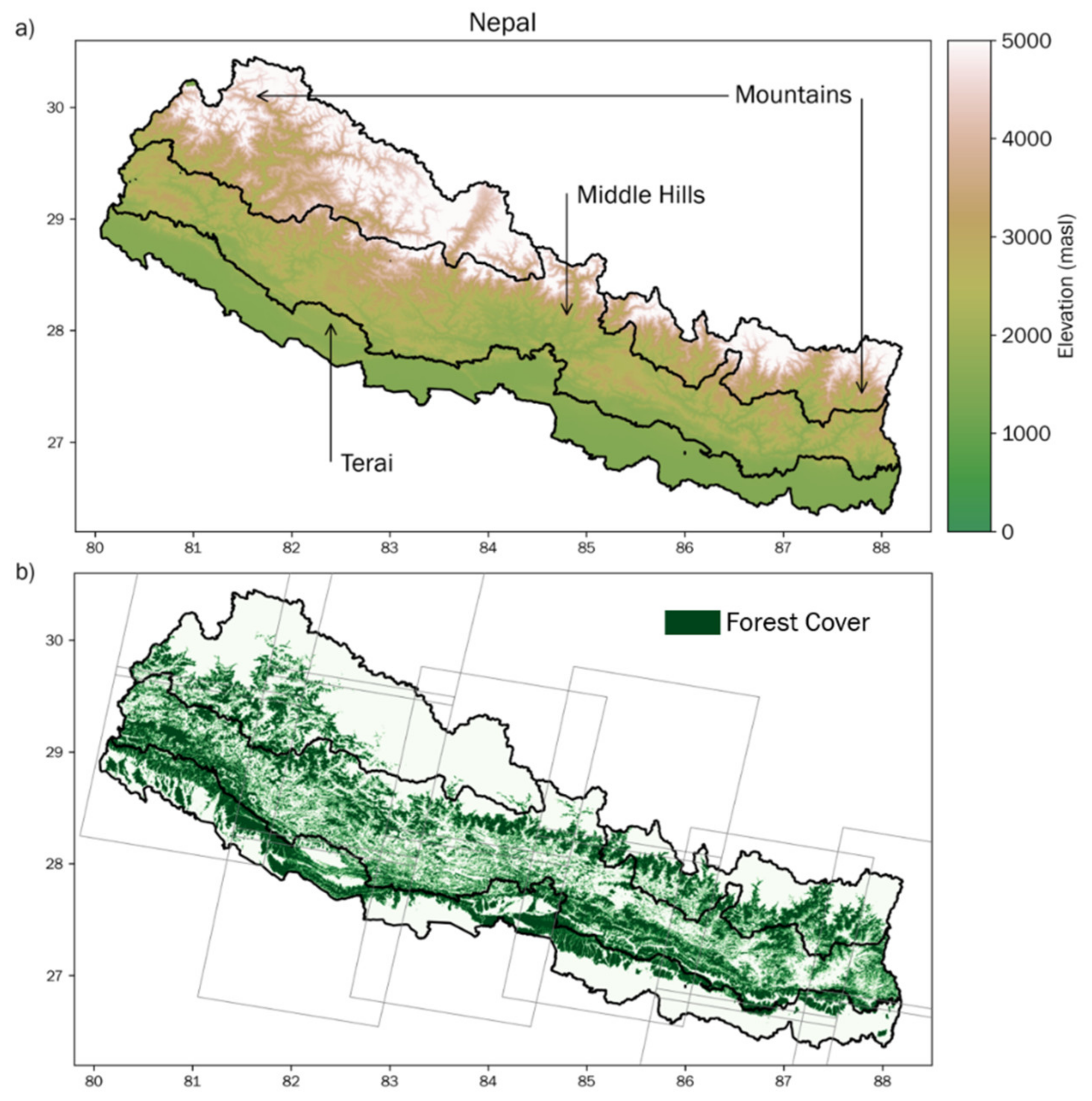
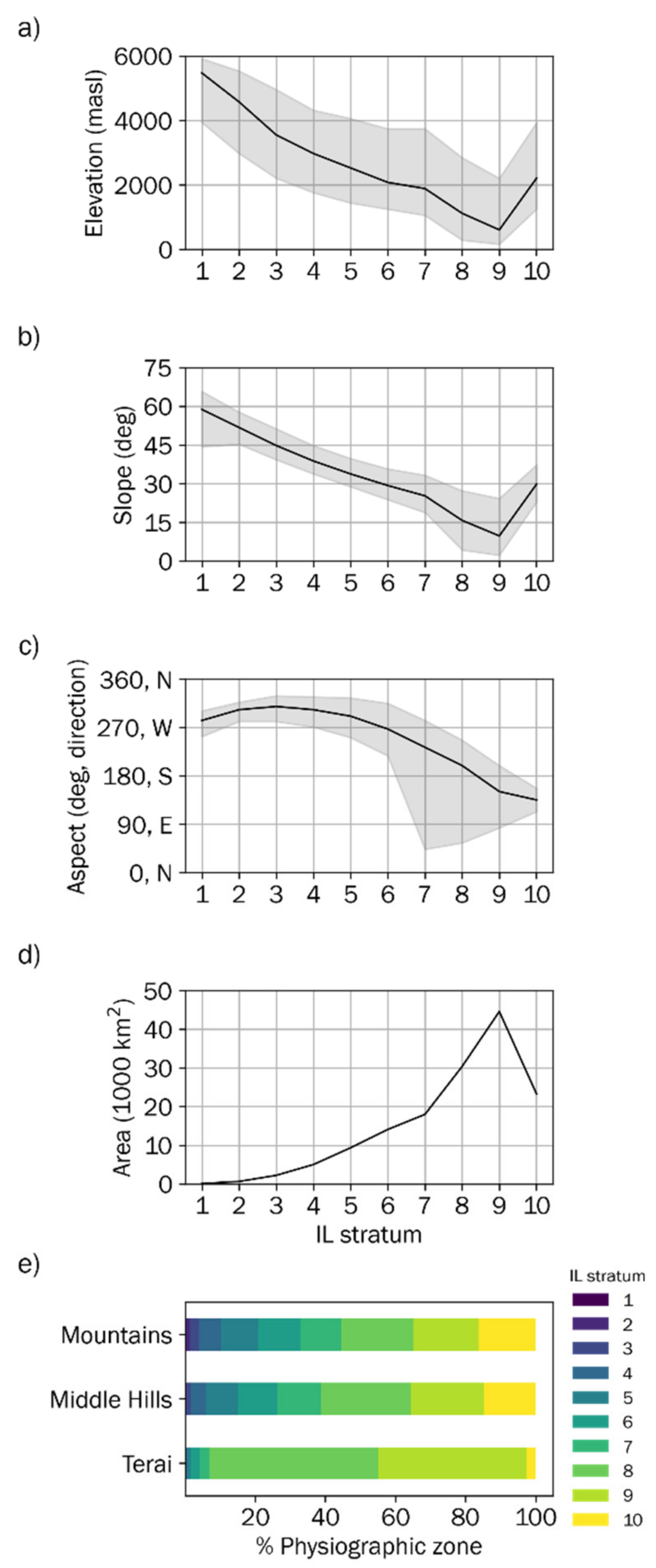

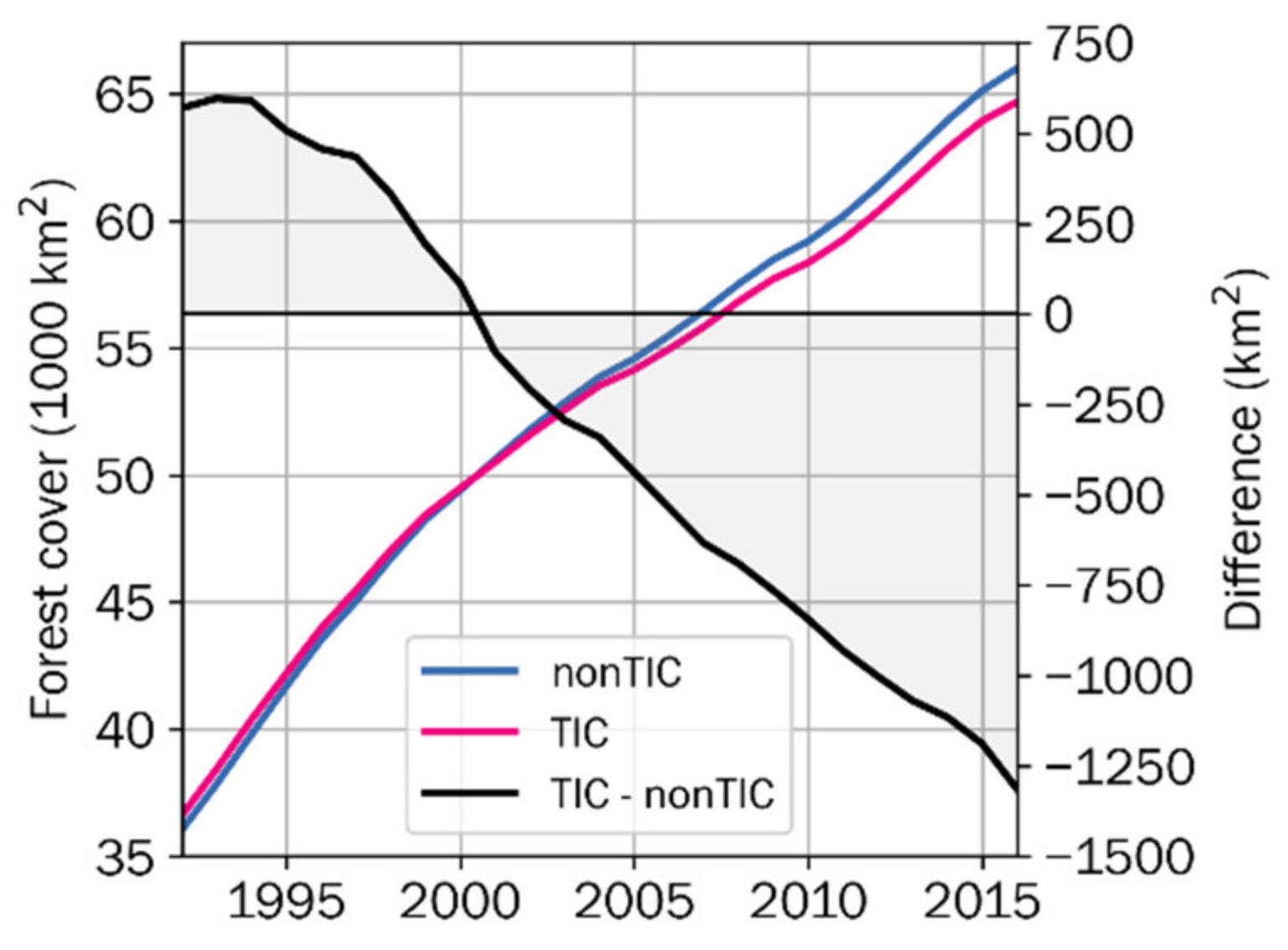

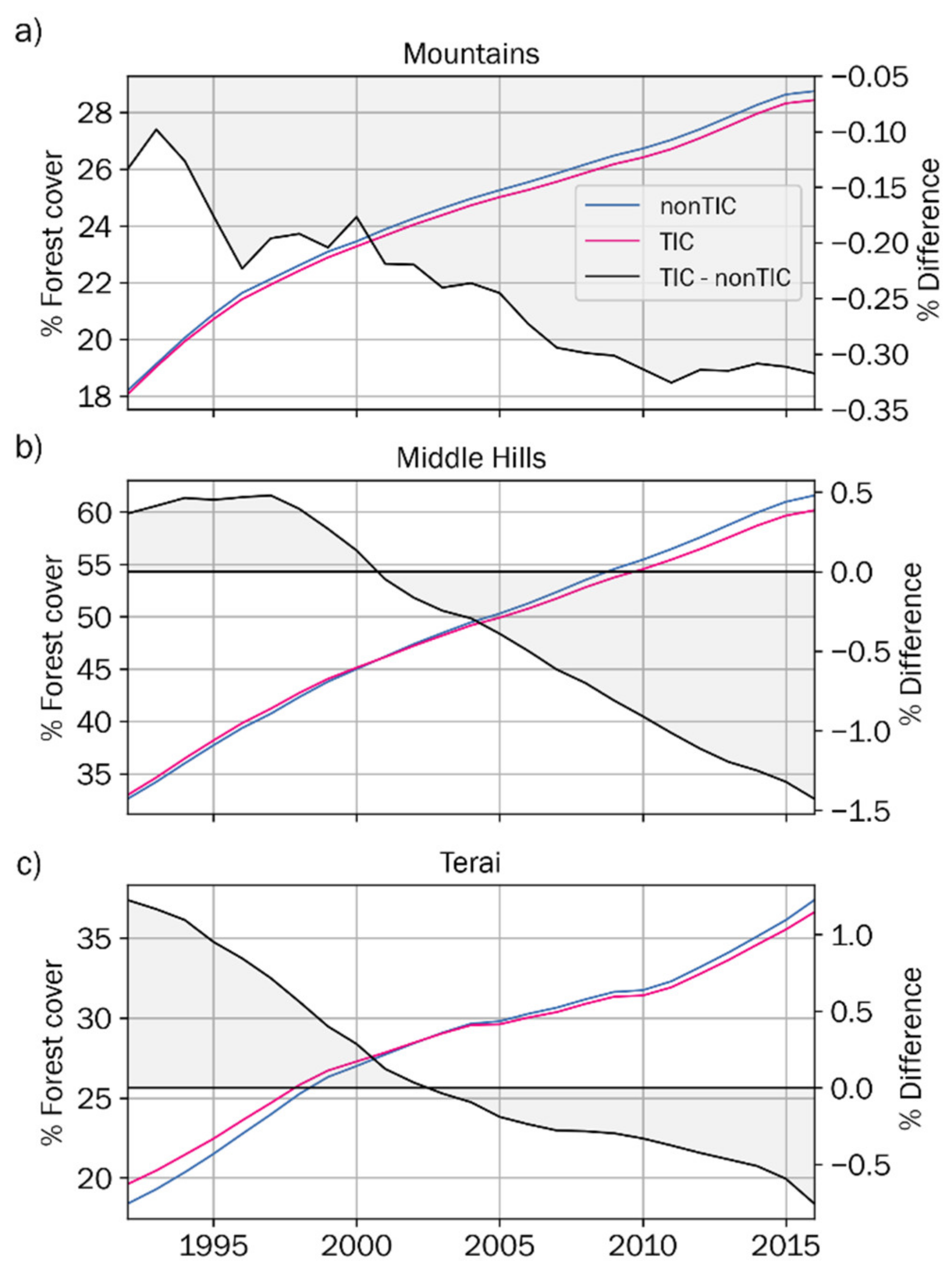
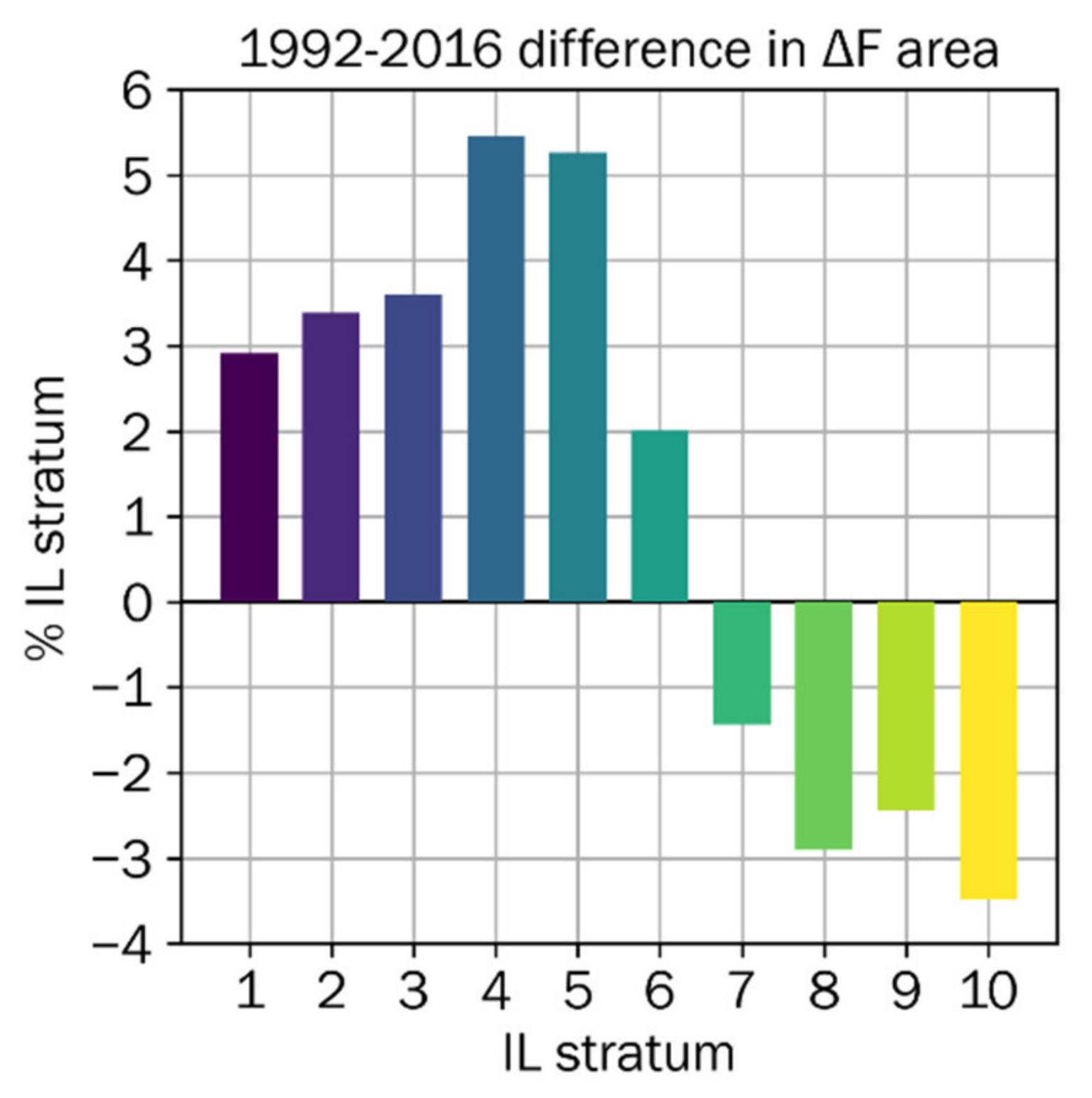
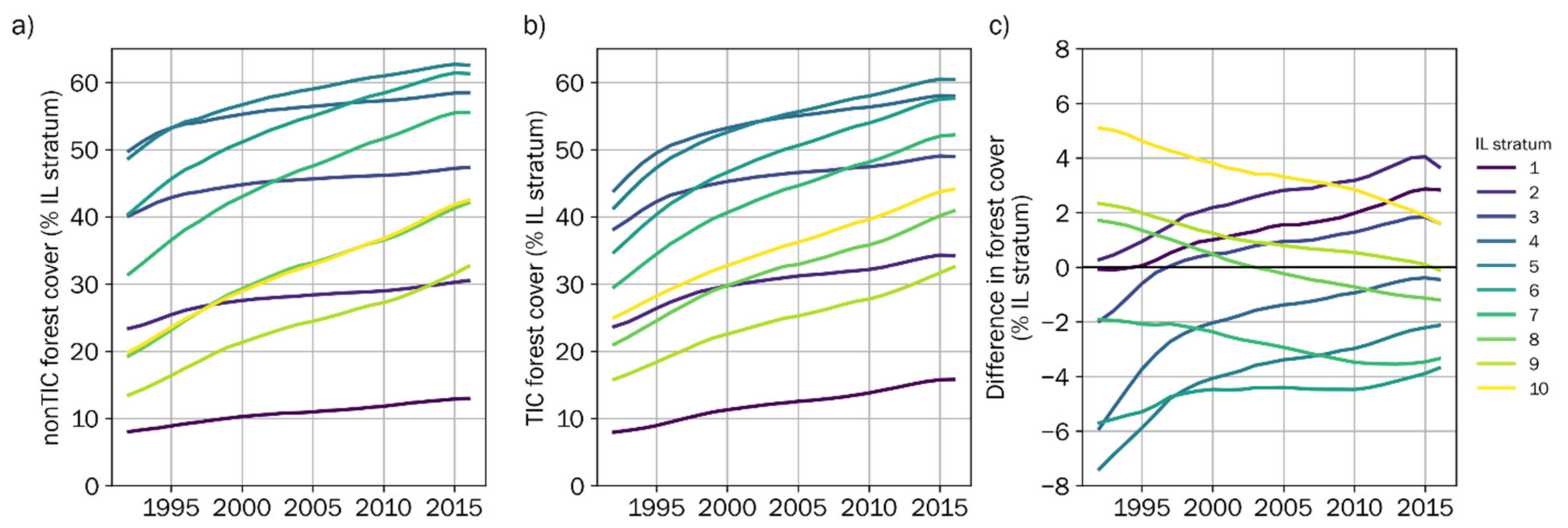
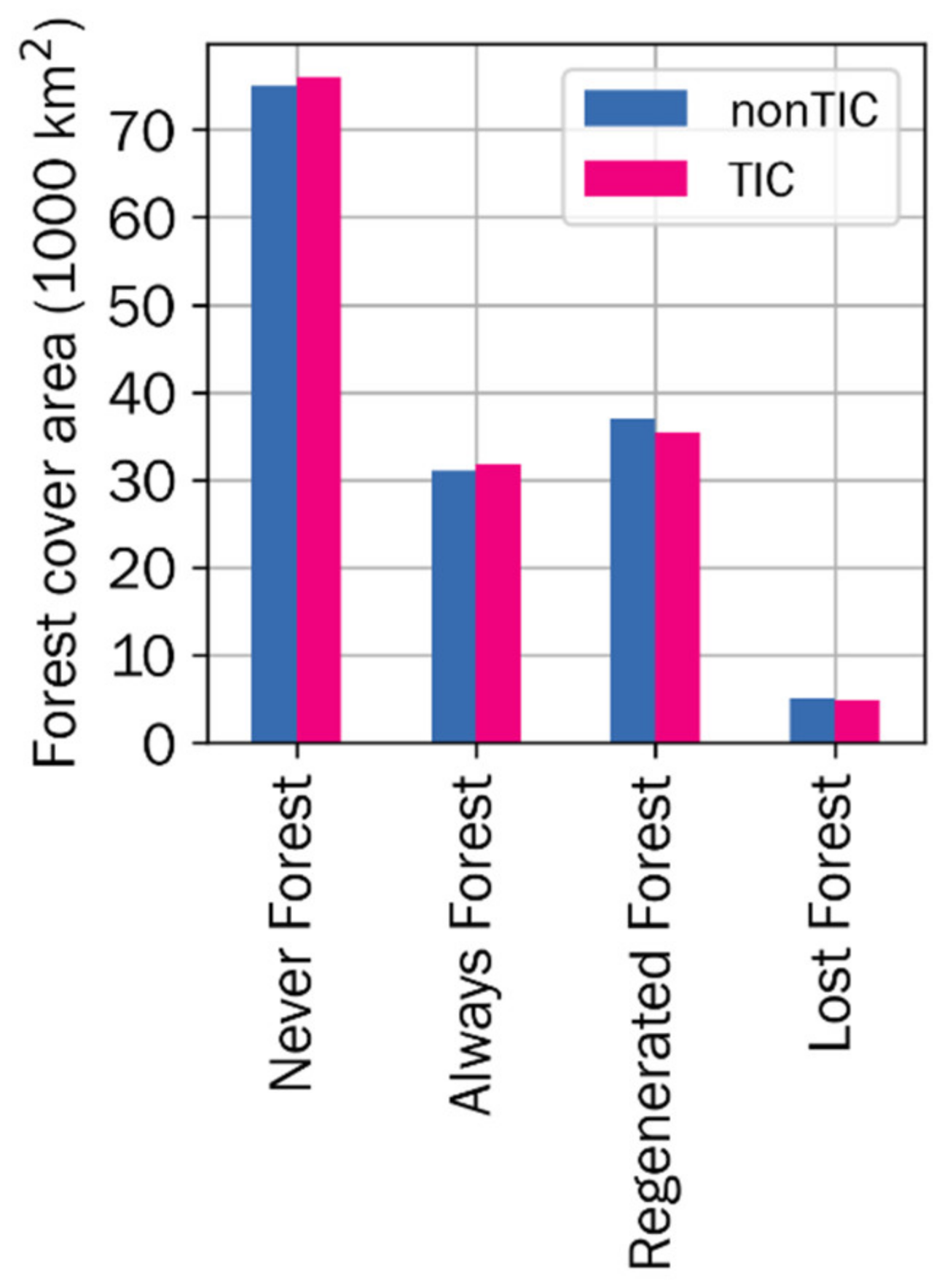
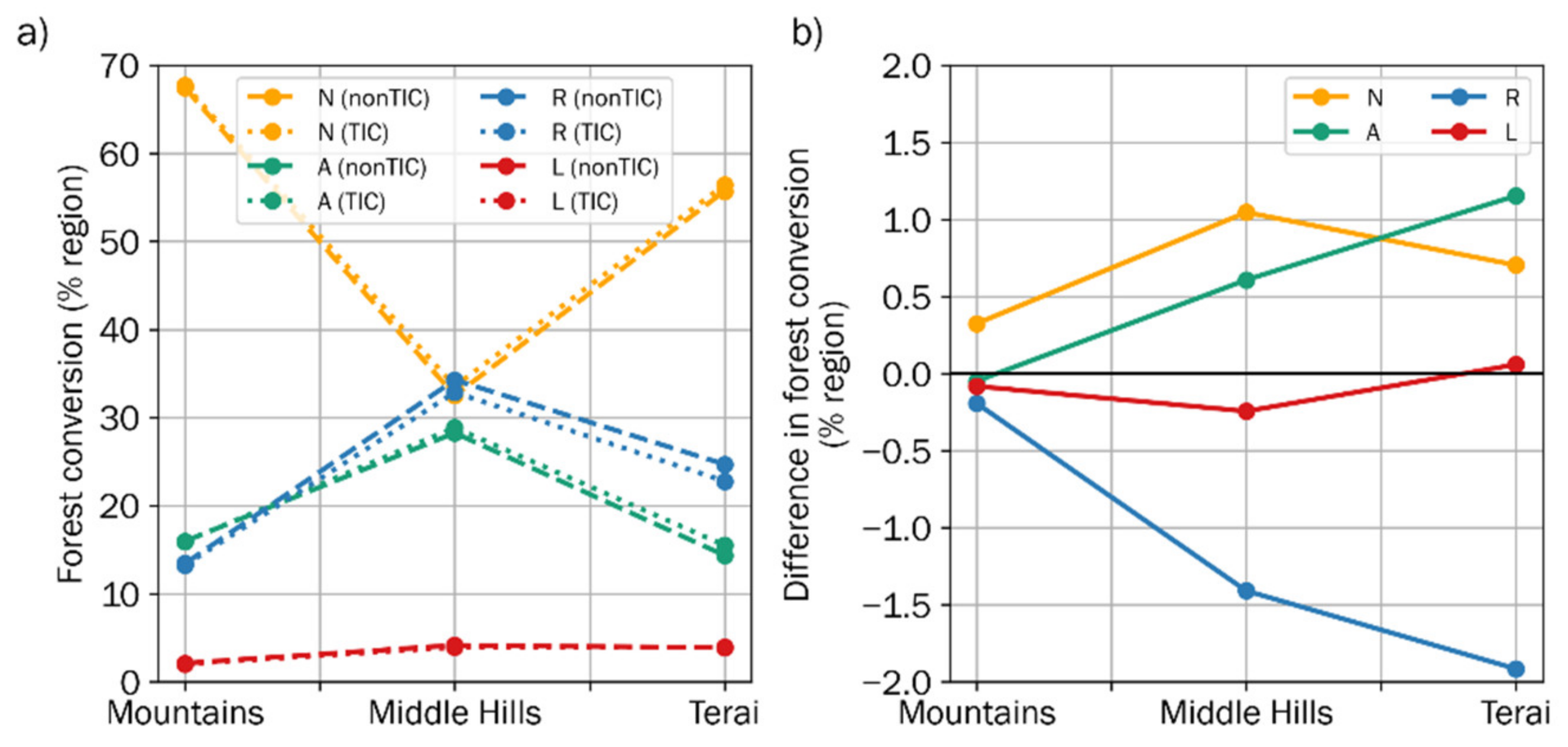
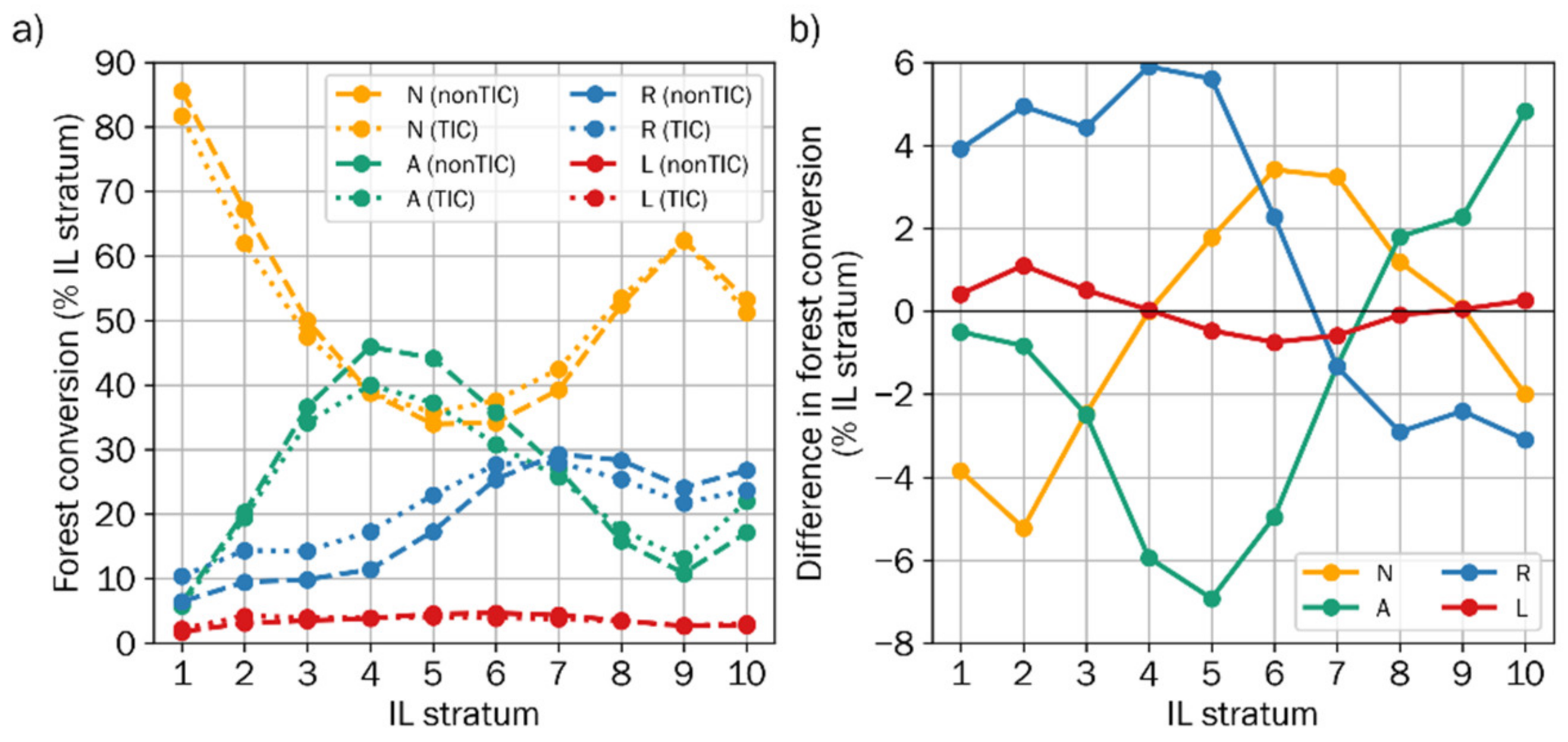

| Image Frequency | Theme | Correction Approach(es) | Study Area | Citation |
|---|---|---|---|---|
| Single date | Forest Cover | Band Ratioing, Cosine Correction, PBM, and PBC | Carpathian Mountains, Romania | [35] |
| Vegetation Cover | Illumination Condition Weighted Mean, Minnaert, C-correction | Cabañeros National Park, Spain | [27] | |
| Band Ratioing, Cosine Correction, Pixel Based Minnaert (PBM), and Pixel-Based C-correction (PBC) | Carpathian Mountains, Romania | [36] | ||
| Land Cover | Teillet-Regression, Cosine Correction, Sun-Canopy-Sensor (SCS), SCS+C, Minnaert, Minnaert-SCS | Shanxi Province, China | [26] | |
| Multi-date | Forest Cover Change | C-corrected and modified C-correction | Peloponnese Peninsula, Greece | [33] |
| C-correction, Statistical Empirical (S-E) and Variable Empirical Coefficient Algorithm (VECA) | Central Adirondack Mountains, United States | [28] | ||
| Bin Tan | Tennessee, California, Utah, and Colorado, United States | [31] | ||
| PBM | Carpathian Ecoregion, Romania | [32] | ||
| C-correction, Improved Cosine, Minnaert, S–E, and VECA | Dong Phayayen-Khao Yai Forest Complex, Thailand | [29] | ||
| Bin Tan, C-correction, Minnaert with slope, S-E, SCS, and VECA | Nepal | [37] | ||
| Time series | Vegetation Cover Change | Lambertian and C-correction | Ebro Valley, Spain | [34] |
| Forest Cover Change | Semi-empirical C-correction | Taita Hills, Kenya | [38] | |
| SCS | Southwest British Columbia, Canada | [39] | ||
| C-correction | Bago Mountains, Myanmar | [30] |
| TIC Model | Accuracy Measure | |||||
|---|---|---|---|---|---|---|
| OOB | Validation | User’s | Producer’s | |||
| Non-Forest | Forest | Non-Forest | Forest | |||
| nonTIC | 89.71 (0.38) | 87.05 (1.81) | 88.24 (4.83) | 85.44 (5.43) | 90.37 (5.17) | 82.17 (8.48) |
| TIC | 90.04 (0.21) | 88.39 (0.35) | 88.28 (3.02) | 88.69 (4.21) | 93.02 (3.23) | 81.48 (5.51) |
| Physiographic Zone | TIC Model | Accuracy Measure | |||||
|---|---|---|---|---|---|---|---|
| OOB | Validation | User’s | Producer’s | ||||
| Non-Forest | Forest | Non-Forest | Forest | ||||
| Mountains | nonTIC | 94.42 (0.68) | 92.48 (1.69) | 93.70 (0.79) | 90.35 (3.32) | 94.44 (1.81) | 89.12 (1.79) |
| TIC | 94.91 (0.18) | 93.25 (1.63) | 94.72 (1.33) | 90.91 (2.33) | 94.33 (1.49) | 91.50 (2.06) | |
| Middle Hills | nonTIC | 86.06 (0.39) | 82.79 (3.10) | 80.69 (4.98) | 85.45 (0.68) | 87.53 (0.80) | 77.75 (6.27) |
| TIC | 85.97 (0.32) | 83.65 (3.41) | 83.29 (4.30) | 84.02 (4.29) | 84.41 (5.75) | 82.88 (4.74) | |
| Terai | nonTIC | 92.01 (0.49) | 92.23 (0.26) | 92.33 (1.60) | 91.96 (5.44) | 96.85 (1.12) | 81.75 (1.94) |
| TIC | 91.69 (0.55) | 91.59 (1.26) | 95.05 (2.91) | 84.21 (9.65) | 92.76 (4.98) | 88.89 (7.48) | |
| IL Stratum | Differences in Accuracy Measure | |||||
|---|---|---|---|---|---|---|
| OOB | Validation | User’s | Producer’s | |||
| Non-Forest | Forest | Non-Forest | Forest | |||
| 1 | N/A | |||||
| 2 | 0.00 (0.00) | 0.28 (1.73) | 0.00 (0.00) | 0.28 (1.73) | 0.00 (0.00) | 0.00 (0.00) |
| 3 | 5.55 (0.00) | 7.16 (4.65) | 0.00 (0.00) | 7.55 (5.09) | 2.23 (1.25) | 0.00 (0.00) |
| 4 | 1.98 (0.03) | 1.24 (4.97) | 0.00 (0.00) | 1.58 (5.85) | 1.58 (2.90) | 0.00 (0.00) |
| 5 | 2.58 (0.00) | 0.63 (2.55) | 3.72 (7.21) | −0.67 (1.21) | −0.75 (3.40) | 1.51 (3.79) |
| 6 | 2.38 (1.13) | 3.35 (3.87) | 0.16 (7.83) | 5.17 (3.46) | 10.93 (4.26) | −1.27 (5.02) |
| 7 | −0.39 (0.69) | −1.50 (3.76) | 0.59 (3.98) | −3.77 (3.74) | −2.65 (2.24) | −0.23 (6.71) |
| 8 | −0.33 (0.46) | −0.23 (2.08) | 0.10 (2.62) | −1.15 (1.98) | −0.58 (0.90) | 0.52 (6.49) |
| 9 | −1.24 (0.60) | −0.92 (1.28) | 0.09 (1.36) | −3.80 (2.29) | −1.37 (0.77) | −0.35 (3.73) |
| 10 | 0.28 (0.76) | −0.66 (4.14) | −1.22 (4.80) | 0.05 (4.29) | −0.43 (3.81) | −0.73 (5.68) |
Publisher’s Note: MDPI stays neutral with regard to jurisdictional claims in published maps and institutional affiliations. |
© 2021 by the authors. Licensee MDPI, Basel, Switzerland. This article is an open access article distributed under the terms and conditions of the Creative Commons Attribution (CC BY) license (https://creativecommons.org/licenses/by/4.0/).
Share and Cite
Van Den Hoek, J.; Smith, A.C.; Hurni, K.; Saksena, S.; Fox, J. Shedding New Light on Mountainous Forest Growth: A Cross-Scale Evaluation of the Effects of Topographic Illumination Correction on 25 Years of Forest Cover Change across Nepal. Remote Sens. 2021, 13, 2131. https://doi.org/10.3390/rs13112131
Van Den Hoek J, Smith AC, Hurni K, Saksena S, Fox J. Shedding New Light on Mountainous Forest Growth: A Cross-Scale Evaluation of the Effects of Topographic Illumination Correction on 25 Years of Forest Cover Change across Nepal. Remote Sensing. 2021; 13(11):2131. https://doi.org/10.3390/rs13112131
Chicago/Turabian StyleVan Den Hoek, Jamon, Alexander C. Smith, Kaspar Hurni, Sumeet Saksena, and Jefferson Fox. 2021. "Shedding New Light on Mountainous Forest Growth: A Cross-Scale Evaluation of the Effects of Topographic Illumination Correction on 25 Years of Forest Cover Change across Nepal" Remote Sensing 13, no. 11: 2131. https://doi.org/10.3390/rs13112131
APA StyleVan Den Hoek, J., Smith, A. C., Hurni, K., Saksena, S., & Fox, J. (2021). Shedding New Light on Mountainous Forest Growth: A Cross-Scale Evaluation of the Effects of Topographic Illumination Correction on 25 Years of Forest Cover Change across Nepal. Remote Sensing, 13(11), 2131. https://doi.org/10.3390/rs13112131






